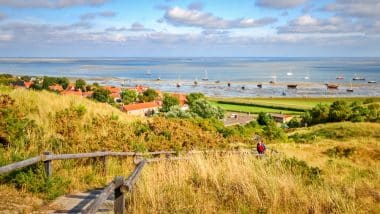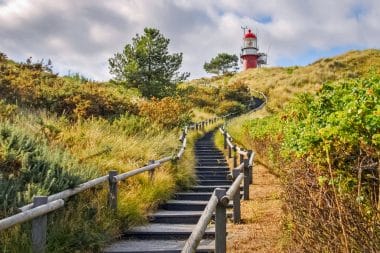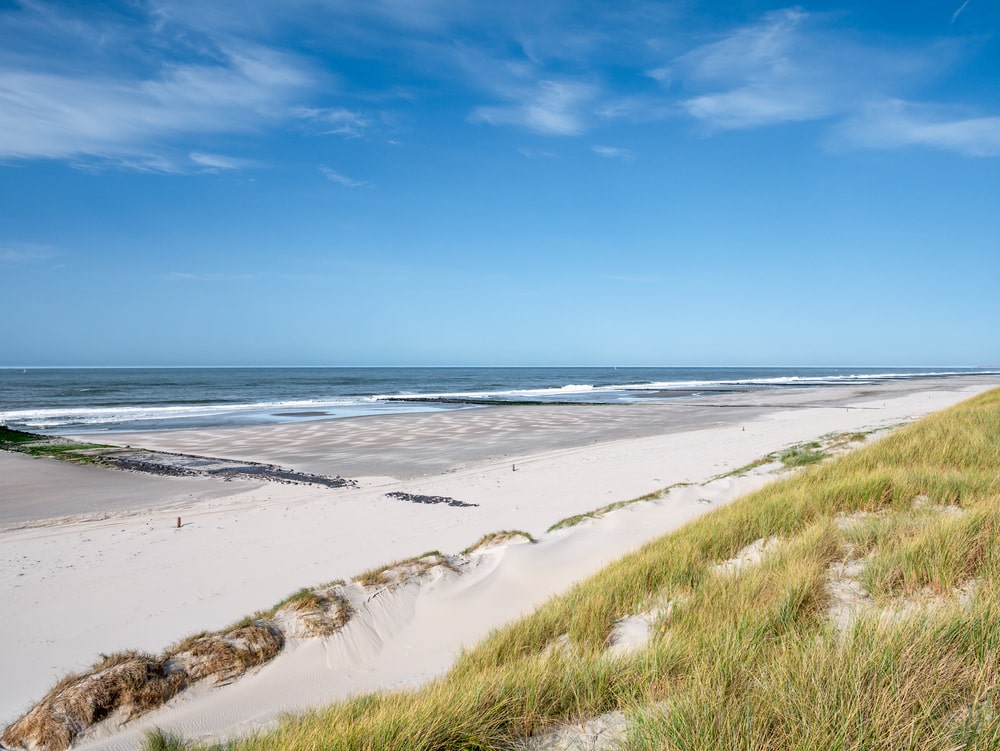Of the five inhabited West Frisian islands , Vlieland does not stand out at first glance: With its area of about 40 km², the island is one of the smaller of the five islands. And yet, located between island highlights such as Texel and Terschelling, Vlieland knows how to convince with a beautiful natural panorama on the North Sea. The island unfolds between dunes-rich stretches of beach, the tranquil and only village of Oost-Vlieland and the untouched sandbanks in the Wadden Sea.
Vlieland – Highlights of the beautiful North Sea island
Framed by the two largest of the inhabited West Frisian islands – Texel and Terschelling – Vlieland is a tranquil alternative for those interested in the somewhat quieter island nature of the Dutch North Sea . Whether it’s a relaxing walk along the beautiful coastal panorama, guided mudflat hikes or immersing yourself in West Frisian culture – there is a lot to experience on Vlieland for passionate North Sea holidaymakers. The beach worlds of Vlieland extend over about 20 kilometres, which offer enough options for travellers to experience the North Sea coast due to their size. The island has a dense network of cycle paths and some beautiful hiking trails. If you plan to explore the nature of the West Frisian Islands from Vlieland, you can do so in many ways. Even boat tours to the sandbanks where the seals rest are offered.
Vlieland and the Wadden Sea
An absolute highlight for nature fans, however, is and remains the mudflats near Vlieland. It is not for nothing that the Dutch Wadden Sea off the West Frisian Islands was designated a World Heritage Site by UNESCO in 2009. The fascinating ecosystem is home to extraordinary sea creatures and coastal animals – from seabirds, exotic fish and crustaceans to seals. But beware: The mudflats should not be underestimated, which is one of the reasons why professionally guided tours are offered on site, which make a safe way through the beautiful natural world on the coast possible. A first important place to go to understand the local Wadden Sea and the natural region around Vlieland is De Noordwester, Waddencentrum en Zeeaquarium. The Wadden Centre and Sea Aquarium also offers a wide variety of excursions – including guided mudflat tours. Because one thing is clear: the fascinating natural world of the Wadden Sea UNESCO World Heritage Site should not be missed as a visitor to Vlieland.
The island world of Vlieland – From the historic lighthouse to West Frisian village life

As beautiful as the mudflats are, it is worth taking a long look at the beautiful geography of the island, which has numerous sights that at first glance seem inconspicuous. A landmark of the island is the local lighthouse, which rises on the 40-metre-high dune Vuurboetsduin. The historic building was built around 1910 and rises about 18 meters into the air. Its striking reddish façade can be seen from afar, blending wonderfully into the island panorama in the North Sea – a popular photo motif on site. More than two hundred steps lead up to the tower, from the point of which, however, in good weather, there is a view over the sea that stretches out for miles. The only village on the island that is worth visiting is Oost-Vlieland, which unfolds right at the foot of the lighthouse. Here you can discover the most important museum on the island next to De Noordwester: Tromp’s Huys. This is where the oldest house on the island is located, whose origins date back to 1575. The museum has been in existence since the 1950s, and it deals with the history and culture of Vlieland.
Coast and sea – The beaches, dunes and sandbanks of Vlieland
Vlieland has a beautiful coastal panorama to offer for all fans of the North Sea. Especially on nice days, hikes and tours to the scenic beach sections that characterize the shores of the island are worthwhile. It is much less crowded here than at some other beaches on the neighbouring islands – so it is wonderful to relax on site in the coastal nature. In the west of the island, the distinctive dune and sand world of Vliehors unfolds. Popular is the tour with the Vliehors Express, which leads through the actually military area, which is sometimes referred to by residents and travelers as the Sahara of the North. One of the region’s striking buildings is the Drenkelingenhuisje, a historic house built in 1890 – and once used as a stop for shipwrecked people. Not far from Vliehors is the sandbank with the largest seal colony on the island. By the way, Vlieland also runs boat tours to the sandbanks with seals – another excursion highlight on the island!
West Frisian Islands – Trip to Texel and Terschelling

Although Vlieland is a comparatively tranquil island, people here do not live isolated from the rest of the West Frisian Islands. There are boat connections to the neighbouring islands of Texel and Terschelling, which are absolutely worth a visit. Southwest of Vlieland lies Texel , the largest of the inhabited West Frisian Islands. More than 13,000 inhabitants live here, and the island is also a popular first port of call for the West Frisian Islands due to its close proximity to the mainland. The beautiful nature areas of De Hors and De Slufter, as well as the Ecomare Museum of Natural History, which is well worth a visit, attract tourist attention. If you orient yourself eastwards, you can visit the island of Terschelling, which has a 30-kilometre-long beach scenery. The island is home to a very special attraction: the Brandaris from the 16th century, the oldest lighthouse in the Netherlands, is enthroned here. One thing is clear: The West Frisian Islands with their mudflats, coastal nature and extraordinary culture provide the best reasons for a relaxing holiday on the North Sea coast. So why not stop off in beautiful Vlieland?


